The music streaming market is experiencing a boom!
While there was a time when a limited audience was using these services, today, almost every individual with a smartphone uses a music streaming service.
The penetration of accessible and cheap internet has certainly made it easier to rely on direct streaming. One of the most popular players in this lucrative market is Spotify.
With over half a billion users, Spotify is the ultimate streaming platform that people use to find their favorite tracks, artists, and playlists to enjoy music. The success of this platform is truly an inspiration for the budding platforms in the market.
Understandably, looking at the market, several entrepreneurs and businesses have shown interest in replicating the success, with a plan to develop an app like Spotify.
If you also fall into the same group, or you just have an interest in knowing more about how an app like Spotify is built, then this is the post for you.
In this post, we will try to answer the most popular question in the minds of budding music streaming app developers and businesses, i.e., how to develop an app like Spotify?
So without further ado, let’s get started!
Understanding Spotify: An Overview of the Best Music Streaming App
Spotify is a music streaming app; this digital music platform provides on-demand music streaming services, letting users play songs, videos, songs, and podcasts.
With billions of songs, podcasts, and audiobooks, Spotify boasts the largest catalog for a listener to explore and is one of the most sought-after mediums for professional artists working in the music industry.
Bringing music to every device, Spotify offers great flexibility and can be used on different devices, including your smartphone, tablet, PC, and more. What makes an app like Spotify the best in the game is its ability to target all types of users, be it through a web app, an iOS app, or an Android application.
The application also offers a premium subscription that allows you to do more and experience your music better. What’s interesting is that Spotify enjoys a decent 40-60 ratio of paying to non-paying users.
is a music streaming app; this digital music platform provides on-demand music streaming services, letting users play songs, video songs, and podcasts.
An excellent example of an innovative music app, the app is embedded with AI-powered algorithms, predictive mechanisms, and a database of millions of songs, with hundreds of new ones added each day.
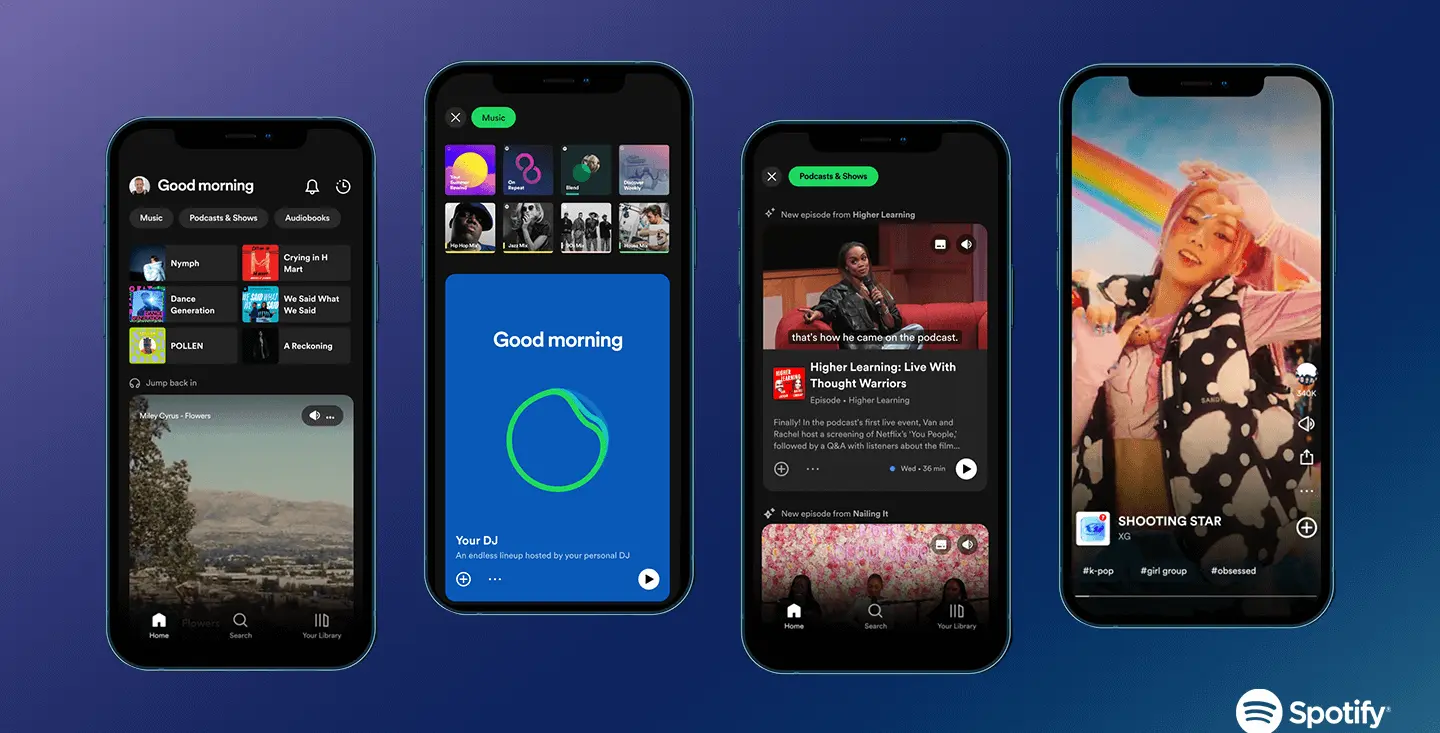
The premium version has more than 270 million subscribers, which is definitely an inspiration for many entrepreneurs planning to build an app like Spotify.
To give you some perspective, let’s take a look at the stats from Q2-2025, which should be able to give you a direct understanding of how fast Spotify as a business is growing:
- Operating Income: €406M
- Gross Margin: 31.5%.
- Total revenue €4.2 billion (15% Y/Y growth).
- Monthly Active Users: 696 million (11% Y/Y Growth).
- Subscribers: 276 million (12% Y/Y Growth).
Knowing all of that, you surely may be wondering, “How do I replicate these results?”. To do so, you need to closely examine how an app like Spotify works, what it offers to users, and what kind of development process should be followed.
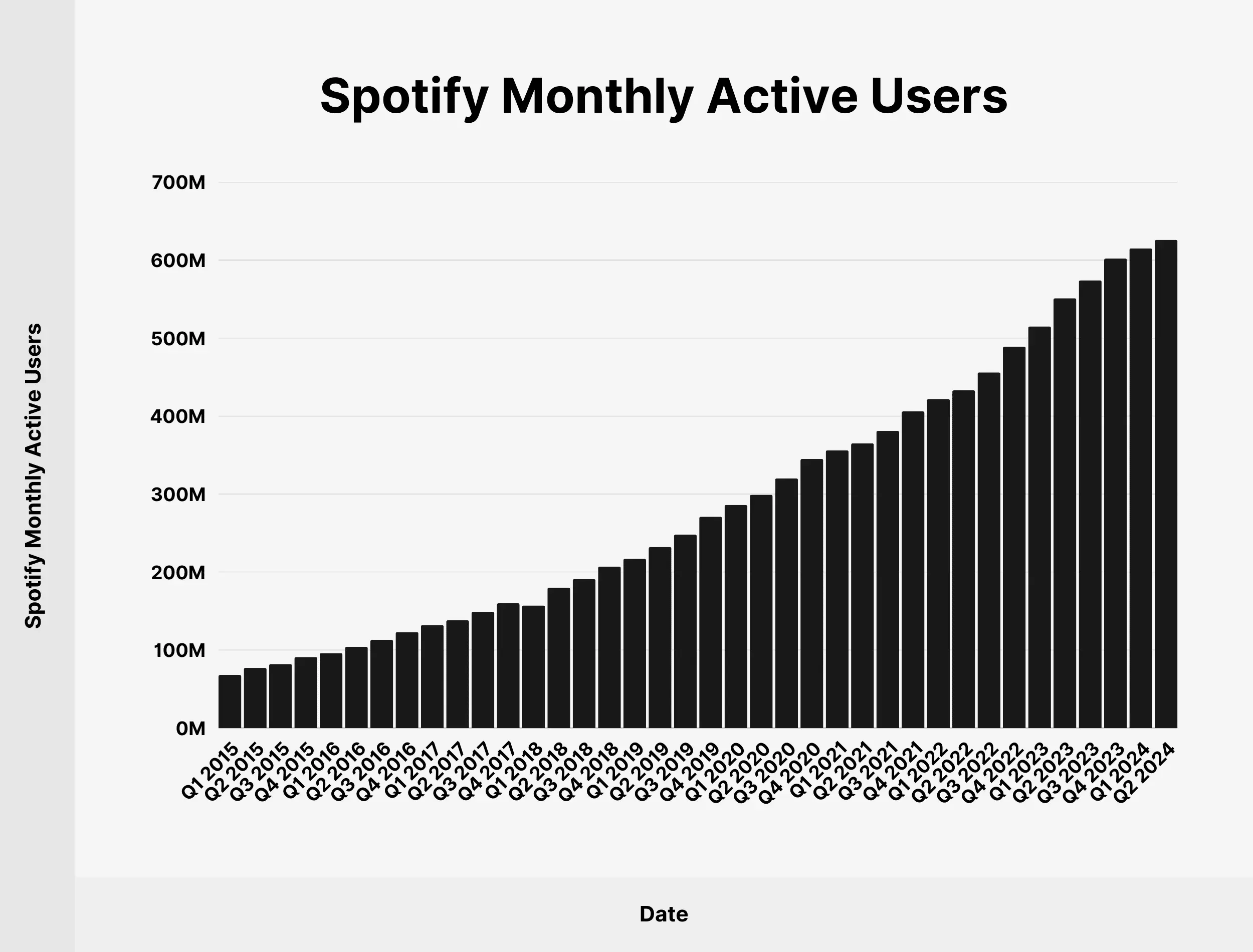
Must-Have Features to Build an App Like Spotify
Developing a mobile app is no big deal; however, what’s difficult is making an app successful among people. This is where features play a big role.
With the right set of features and functionality, any music streaming app can replicate Spotify’s success, and even surpass it, for that matter.

To start your journey of building an app like Spotify, the first step is to identify the core features that are essential for your music streaming app.
1. Registration
Registration is the core functionality of any cross-platform and on-demand app.
Users can register on the platform using their phone number, email, Google Account, or Apple Account.
This is an important feature when creating an app like Spotify, as it enables cross-device data synchronization.
When users log in with their credentials to any device, they will find their recommendations, playlists, and favorites right in front of them.
2. Profile Creation
Registration and profile creation are two entirely different processes, regardless of their interrelation.
To make it simpler for you, once the user is registered, they may or may not choose to create a profile.
If they do, they can set their birthdate, location, profile picture, favorite artists, songs, recommendations, and notification settings.
This helps the music streaming platform make the user experience and personalization a lot better. Thus, making it an important feature of the Spotify app.
3. Authentication
Your music is your own business, and to keep people out of it, Spotify-like apps come with an authentication feature.
Manual or biometric authentication adds an extra layer of security to the music app.
Though some might see it as over-the-top, it becomes quite important when the user has paid for a premium subscription.
4. Music Library
No music app is complete without this feature. The music library lets users find and play their favorite music without the need to download it.
It’s quite hassle-free and one of the basic functions of every music streaming application, making it easier for users to navigate and access the best selections of songs and other streamable content.
5. Search
As the name suggests, this feature in apps like Spotify enables users to look up new music.
The fun part is that the advanced search functionality makes it super easy to do that.
You can find the particular song with the album name, song title, artist name, and record company, and if you don’t remember either of those, just look up a part of the lyrics.
6. Playlist Creation
Another important feature of every music streaming app is playlist creation. This is an absolute booster of user engagement.
This functionality enables users to create a playlist. Users can either add music to the list as they go or they can use the dedicated playlist creation feature to do it in one go.
Or, they can use a mix of them.
7. Social Sharing
What is social sharing, you ask?
Well, this feature lets users share the music they are listening to on apps like Instagram & post it on their stories.
Social sharing features have become the norm today and are a good way to use the vast user base of social media to advertise the platform.
8. Offline mode
Offline mode is one of the user’s favorite features.
As it is evident, this feature enables the user to save their music offline to play when they aren’t connected to the network or even Wifi.
This lets users access all their offline music and playlists, with the condition that their phone is running. More often than not, this is a feature that is offered in the premium package.
9. Push Notification
This feature enables the app’s team to send alerts and notifications to the user. This isn’t just used for promotions.
It also informs users that whenever there is a new album release, their favorite song is available, or they need to renew their subscription.
10. AI Recommendations
Based on the preferences that users have fed the app, their music streaming history, favorite artists, listening time, and other such factors, AI in music streaming allows the app to drive personalized user recommendations.
This is an Industry 4.0 level feature that the best music streaming apps, including Spotify, should have on their feature list.
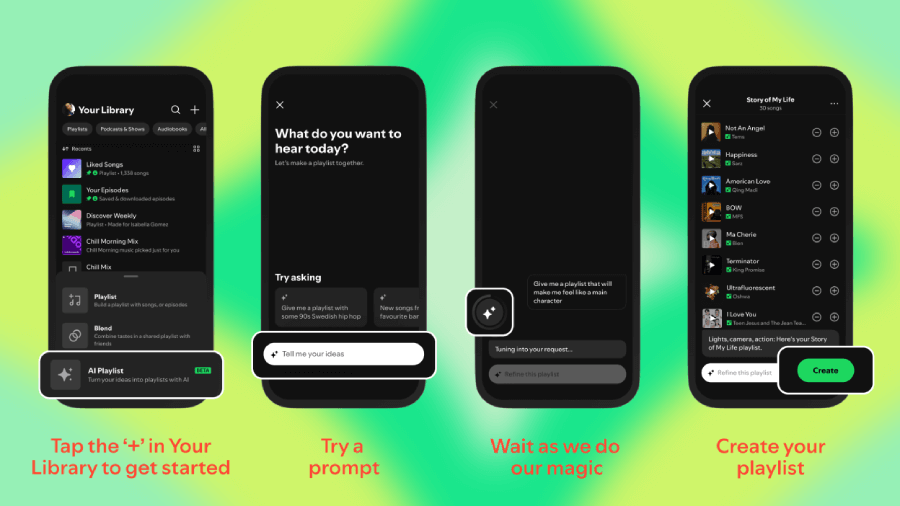
11. Lyrics Display
Don’t you hate it when you can’t understand just that one line of your favorite song? Well, with the music streaming application solution, you don’t have to scour the internet looking for lyrics.
Instead, the lyrics display feature will display real-time lyrics of the song within the app. This saves a lot of time and mental gymnastics.
12. In-App Messaging
This is a rather advanced music streaming app feature.
In-app messaging is a feature that has taken place in some of the best music streaming applications over recent years.
As you might have already guessed, this enables the user to chat with others. They can share music, listen to music at the same time, and such things.
This is yet another feature that drives user engagement.
13. Music Event Calendar
Lastly, we have a music event calendar feature.
This is a feature that is more suited for music apps for a band-type solution, but can be embedded into music streaming solutions, too.
What it does is show the user a calendar of upcoming music fests and events based on their location or presence.
These are the important features that you should include when you develop an app like Spotify.
Other than these features, there can be several additional features that you can identify during your app development research.
With that said, let’s take a closer look at the entire process in the next section!
Steps to Develop an App Like Spotify
Building a music streaming app can be tricky. There are several challenges of music app development that you might encounter when planning your streaming app.
Fortunately, when planning an app like Spotify, you already have a reference point to begin with, which allows you to follow a path.
However, when you are in the market, building an app that already exists won’t take you far. Hence, keeping the reference in mind, you must try and innovate.
Here’s a series of steps that can help you develop an app like Spotify –
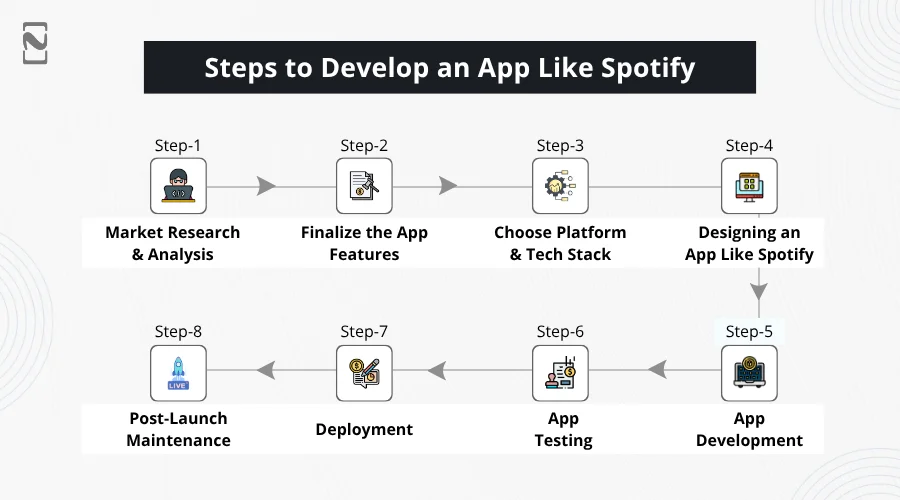
Step 1: Market Research & Analysis
Mobile app development starts with an idea. Once you have that, we need to get a little more technical and start with market research.
Mobile app market research is an essential part of learning about competitors, barriers to entry, market situation, forecasting the right time to launch the app, and many other things.
The information gathered during the market research phase works as the fuel for the entire development process.
As a general rule of thumb, the more effort and resources you put into research and analysis, the higher the chances you have of creating a successful music streaming application like Spotify.
Step 2: Finalize the App Features
We have discussed the importance of features before, and here we will discuss it again.
So the question is, how do you choose the latest Spotify features for your application? Well, this is where the information about the target users you acquired in the previous step comes in.
The platform should have features that cater to your target audience.
In addition to this, for the app to be smooth and innovative, there should be a healthy mix of basic features & advanced features.
Another option is MVP development.
MVP stands for minimum viable product, which works as a mockup app. It can be used for cross-checking the concept and getting approval from the stakeholders. Or even generating investment for the project.
Step 3: Choose Platform & Tech Stack
With the music streaming app features done, it’s time to get a little more technical. There are two things we need to deal with, the first one being the “app development platform”.
There are three major options here.
You can either go for native platforms, choosing between Android app and iOS app, or you can go for the cross-platform option to create a hybrid app.
Choosing the right platform is super important as it not only affects the cost of creating an app like Spotify, but also the look and feel, performance, and market performance of the app.
Done with this, we will move on to the tech stack.
First of all, what is the mobile app tech stack? It refers to the set of technologies used for mobile app development. This covers everything from programming languages and toolkits to frameworks and testing tools.
Again, choosing the right set is super important as it can affect everything related to the music streaming application.
Step 4: Designing an App Like Spotify
When it comes to UI/UX Design, there are hardly any apps that compete with Spotify. If you want to replicate it, you need to hire mobile app developers who are experienced and, more importantly, creative.
The design of a music streaming app should be easy to navigate, most of all. But it should also have the right amount of creative aspects that keep users in awe.
A unique mix of your app’s personality and creativity is what gives birth to the perfect design that represents the platform in full glory.
After all, it is next to impossible to drive user engagement on a music streaming platform without a good design.
Step 5: App Development
This is the part where dedicated developers will be writing the source code, combining the different parts of the app together, integrating APIs and other third-party components, and making the app as functional as visually appealing.
Due to the amount of work put into developing an app like Spotify, this step is the most time & resource-consuming part of the entire development.
For that reason, it is recommended that you, as a client, maintain good communication with the development team. This helps ensure the product is turning out how you want it.
Step 6: App Testing
Done developing media streaming apps like Spotify? It’s time to test it.
Mobile app testing is a complex process on its own. Though the testing process runs in parallel to the development process, there’s a final round of testing to ensure the quality of the app.
If any inconsistencies, bugs, or errors are found, they are fixed. This is also the step where final changes are made, if any, from the client side.
Once all of this is done, the app is sent for deployment.
Step 7: Deployment
It’s time to launch your version of Spotify into the market.
Now, this is quite a simple step, but the process to deploy highly depends on the app development platform.
In any case, the time it takes for the app to be approved is 2 weeks.
While the Android side is quite lenient on its guidelines, don’t expect any oversight from Apple; they will disqualify the app for even a slight diversion from their guidelines.
Speaking of which, while waiting for the app to be deployed, you can start the mobile app marketing process.
Step 8: Post-Launch Maintenance
Work doesn’t end with deployment.
To make sure your app doesn’t sink to the bottom of the ocean of millions of apps in the market, you need to maintain it.
This is where mobile app maintenance services come in.
Combining the above steps with the latest music streaming app trends, you can easily get your hands on a well-designed and fully functional music streaming app like Spotify.
The process is tried-and-tested, which means all you need to do is implement it diligently. However, not all can implement it as expected. Hence, you need a team of professionals to help you build a Spotify-like app.
Before you start your quest to find the right app development team for your music streaming app, let us quickly take a look at how much it is going to cost you.
How Much Does It Cost to Create an App Like Spotify?
On average, the cost to develop an app like Spotify ranges between $25,000 and $200,000.
Much like any other mobile app, Spotify-like app development cost depends on a range of factors like complexity, features, platform, tech stack, and so on.
To give you a better idea of it, here’s a table with a breakdown of the cost of developing an app like Spotify.
| Factors Affecting Cost | Time Impact | Cost Range |
| Basic Features | 200 – 400 hours | $5,000 – $10,000 |
| User Interface Design | 100 – 200 hours | $2,000 – $15,000 |
| Music Streaming Functionality | 300 – 600 hours | $2,000 – $15,000 |
| User Authentication/Accounts | 100 – 150 hours | $3,000 – $10,000 |
| Search and Discovery | 150 – 250 hours | $2,500 – $4,000 |
| Playlist Creation | 100 – 150 hours | $1,000 – $12,500 |
| Offline Listening | 150 – 250 hours | $2,500 – $10,000 |
| Social Sharing Integration | 100 – 150 hours | $5,000 – $15,000 |
| Admin Panel | 150 – 300 hours | $2,500 – $16,000 |
| Testing and Debugging | 200 – 300 hours | $2,000 – $10,000 |
| Platforms (iOS, Android) | Varies based on complexity | Additional cost |
| Third-Party Integrations | Varies based on integrations | Additional cost |
| Total Cost | 1,000 to 2,3000 hours | $25,000 to $2,00,000 |
The range of the minimum and maximum cost varies significantly, as all your decisions lead to the final quote.
In fact, it can even go further than $200,000, as it depends on the features and technologies you plan to integrate into your app.
The urgency of time-to-market also contributes to the final price.
Spotify Business Model
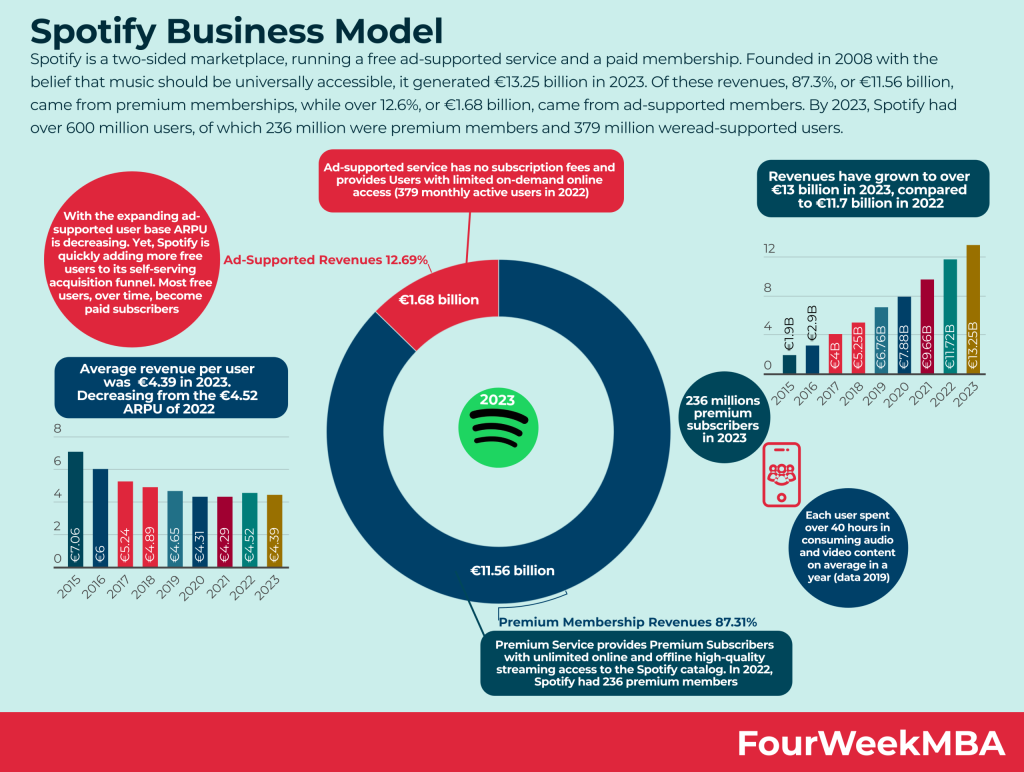
Monetization Models to Create an App Like Spotify
Now, you may be wondering how a music streaming app recoups all this investment?
Well, various monetization strategies are directly/indirectly used to earn money through it.

Check out the following list of solutions that are used for more details on how an app like Spotify makes money!
► Paid Membership
Have you ever used Netflix? This OTT app is the best example of a paid membership, or what we call a subscription-based app.
In order to access the content of the platform, you need to first subscribe to one of the many plans. In the music world, Apple Music has been employing this model for a long time now.
Moreover, if your platform has a strong user base, this monetization model can be super beneficial.
► In-App Ads
If you’ve ever used a music streaming app, you already know what in-app advertisements are.
These are the small personal sections you see embedded in the app interface and the advertisements you hear between the songs.
For users, this is a small price to pay, getting a free music streaming app with millions of songs. And for the platform, this is millions made in revenue while keeping the app free.
This is a strategy that every major music streaming app like Spotify employs. Therefore, you must consider including this in your app too.
► Freemium Model
This is a mix of the two strategies we discussed above.
The freemium word stands for half-free and half-premium. In other words, the basic version of the app is free for everyone to use, but they have to endure in-app advertisements.
On the other hand, if they choose to go for ad-free listening and access to the latest releases, they must buy the premium plan.
Done right, the freemium model can be a great revenue generation strategy.
Here’s a report that supports the statement: Ad-free listening is the top reason for paying for a music streaming platform, as per IFPI.
In addition to this, people are willing to pay a monthly price of up to $1,0 as per Forbes for the subscription.
► Coupons and Promotions
Coupons and promotions are a rather fun monetization strategy that adds a lot of excitement to the platform.
What you can do here is start a referral program where, if someone downloads through the user’s shared link, they get credit or some form of reward.
On the other hand, you can charge artists and companies to promote their music on your platform. This can generate a lot of revenue.
After all, music streaming is driving the entire industry’s revenue.
► Data Monetization
Lastly, we have data monetization.
So, what does this mean? If you have ever heard of big data that is used in industry-wide research and analysis, how is it generated?
That’s right, through apps like Spotify. With a large user base, these platforms are perfect hotspots to generate data.
So, these are the app monetization strategies that you can use to generate revenue through your app like Spotify.
How Nimble AppGenie Can Help You Build an App Like Spotify?
If you are looking for someone to take care of the development, we might have just the right solution for you.
Our team of professional developers offers vast experience in music streaming app projects that perform well in the real market.
Developing a music streaming application is definitely our forte as we have delivered several similar projects in the past years.
With a dedicated pool of experts, we can guarantee on-time completion of your projects, with minimal to no bugs.
What makes us the perfect Music Streaming App Development Company for your music streaming app project is our creative approach and bug-free code.
Reach out today to start your project instantly!
Conclusion
Music streaming apps like Spotify show us how much potential there is in the industry. This is something that the statistics back up, as today, more than 80% of revenue is generated via music streaming.
Now, if you want to create such an app, there are a few things that you must keep in mind, the first one being the value proposition, features, revenue generation potential, and development cost.
Hope all the information shared gives you a clear roadmap to building an app like Spotify. That will be all for this post.
FAQs
The music streaming app development process to create a solution like Spotify goes as follows:
- Market research and analysis
- Finalize the app features
- Choosing the Right Business Model
- Choose Tech Stack
- App Design & Development
- App Testing
- App Launch and Maintenance
The cost to develop an app like Spotify can range between $25,000 and $2,00,000, depending on different factors like complexity, feature set, platform, and so on. For more details, you can contact us.
Much like cost, the app development time on average ranges between 4 to 12 weeks, but can fluctuate based on the project specifications. Contact an experienced development company, and they might be able to offer you a more accurate estimate.
Technologies used to develop an app like Spotify include:
- Programming languages like Java, Swift, and Kotlin
- Back-end tech skills like AWS, Google Cloud, or Azure
- Audio streaming technology like MP3, AAC, Ogg Vorbis, or FLAC
These are various monetization strategies that you can use to earn money with an app like Spotify. Some popular ones are In-app purchases, Freemium models, Paid apps, and Advertisements.

Niketan Sharma, CTO, Nimble AppGenie, is a tech enthusiast with more than a decade of experience in delivering high-value solutions that allow a brand to penetrate the market easily. With a strong hold on mobile app development, he is actively working to help businesses identify the potential of digital transformation by sharing insightful statistics, guides & blogs.
Table of Contents




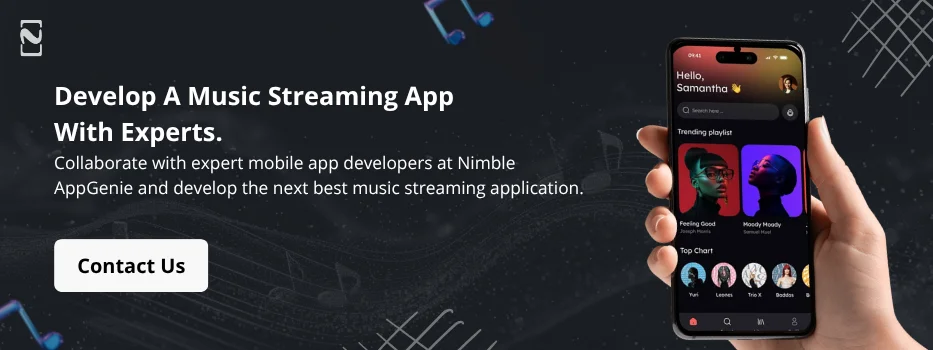
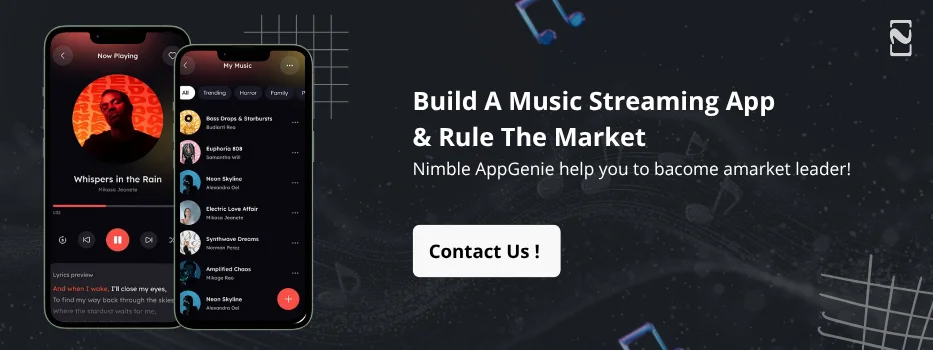

No Comments
Comments are closed.